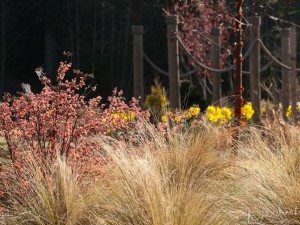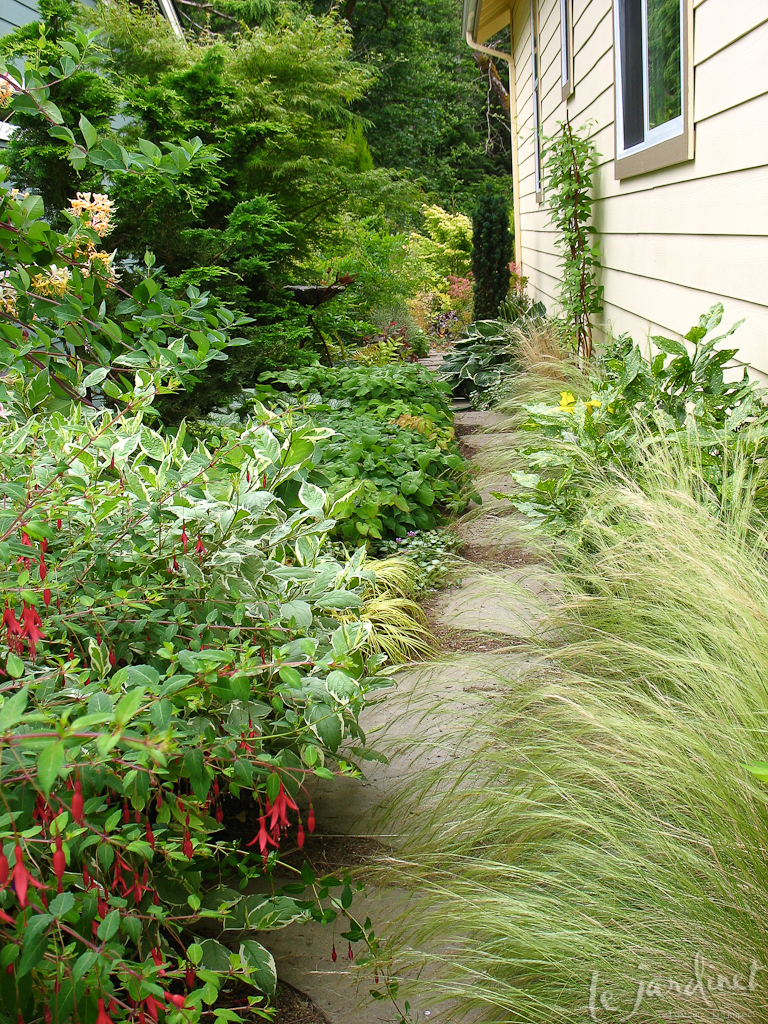The Grass with Multiple Personalities
A beauty or a beast? A star or a supporter? You decide.
Considered invasive in many parts of the country Mexican feather grass (Stipa tenuissima syn. Nasella tenuissima) is merely 'friendly' in Seattle area gardens. Certainly it self seeds, but it does so politely creating serendipitous plant partnerships that I wish I could claim as my design!
I consider it an invaluable asset to my own garden as it fills many roles.
Four season interest.
Being evergreen this offers winter interest, when many of my other favorite grasses have tucked themselves under a blanket of compost. Whether planted as a drift with other grasses or as a simple monoculture, there is no denying that this wispy grass adds softness to the stark landscape during the colder months of the year.
Oscar worthy as supporting actor
Sometimes bolder plant forms need an ethereal background to showcase their strength. I love the way Mexican feather grass offers a hazy curtain behind my 'Ascot Rainbow' spurge (Euphorbia). It keeps the focus on the star with its gauzy texture allowing light to filter through.
Nominee for best actor
With so many great plants in this border (right and at top of post) how can a humble grass be taken seriously as a lead player? By virtue of it being at the very front where it creates a picture frame which in itself is a work of art. Just look how beautifully it sets the scene on this early spring day, enhancing the warm tones of the emerging spirea foliage foliage while leading the eye to the cinnamon colored peeling bark of a young paperbark maple (Acer griseum) in the middle ground and drifts of daffodils beyond.
Perfect for pathways
Grasses are wonderful for edging pathways, delicately brushing bare ankles and toes as though walking through a meadow. None are gentler than this grass and its billowing form blurs the boundary between garden border and flagstone pathway with ease.
Wildlife refuge
Tucked away behind the waving strands of grass, a flock of birds jumped and jived around this little fountain for over half an hour! Safe from view (mostly!), they played their game unhindered. I am sure the seeds would be of interest later in the year also.
Extreme contrasts
Want the ultimate plant to contrast with the grass texture and form? What about this prickly pear? You can't get much more extreme than this!
Cultural information
USDA hardiness; 6-10
Size; 2' tall and wide as a loose fountain
Light; full sun or light shade
Water; average to dry.
So what is this grass to you? The ultimate invasive thug to be avoided at all costs? If so I'd love to know what you have found as a great substitute?
Or has this chameleon found a spot in your garden?
Friend or foe? You decide.
For another great design using this grass enjoy this combination featured in my new book Fine Foliage







Here in San Diego, the Mexican Feather Grass is very popular in the seaside gardens because of it's great character. However, it's extremely invasive and ready to jump ship anytime and take over our ever shrinking native areas. And as much as our clients try to tell us they will upkeep it, you never know when they'll go on vacation during the flowering season or if they sell the house, will the next person know about it? I try to replace it whenever my client asks for it with either Sesleria autumnalis (Autumn Moor Grass), Melica imperfecta (California Melic) or our native Carex pansa (California Sedge Grass). All of which have the same texture and can either be fillers or specimens but aren't nearly as invasive or attention needy as the Feather Grass.
Great ideas Michelle – thank you for sharing your experience
I absolutely adore this grass and am delighted to see it in so many lovely photos here, Karen! I hear complaints here occasionally about its being "overused," but that's a criticism that always makes me roll my eyes a little — no one gardener in particular is overusing it… It's native to this region (well, technically the Chihuahuan desert, which begins about 50-75 miles south of here), so invasiveness isn't an issue. We call it "silky threadgrass" rather than Mexican feather — probably because it has a relative called "needlegrass" which has painfully prickly seeds. It's one of my all-time favorite plants in wind. Absolutely mesmerizing — like watching a fire or a waterfall.
Hi Stacy – I remembered that you liked this grass but didn't know it had a different name in New Mexico! Mesmerizing is right. We're both lucky that it isn't a problem child in our areas!
I have been admiring this grass for a few years and thinking where I could actually grow it in my shady garden. In the mid-Atlantic, I have never heard anyone say the invasive word but I can see how it could be, that's what grasses do.
It will do better in sun than shade although dappled shade would be fine as would full morning sun but afternoon shade. It looks a bit bedraggled in a lot of shade.
I can't imagine my garden without this grass. We live just on the eastern edge of its native range in central Texas so there is not much danger if it should escape. It does reseed everywhere in my gravel garden but has not invaded the neighbor's yard yet. It is in full hot sun for most of the day and lives on rare rainfall so it's perfect for our climate.
Sounds like it's even tougher than I thought!
Hi Karen, first, I am enjoying my copy of your book very much! It will be a great resource! Second, beautiful though it is, I am scared to death of any plant with grass in its name. I deal constantly with invasives here, and I don't need to add another one! I would consider growing it in a pot, as I have had several annual grasses in pot arrangements and thought they were lovely.
Deb, I'm SO glad you like the book!
I understand the grass fear issue. We struggle with non-native highly invasive reed canary grass in our wetter areas and I always panic when I see that genus being sold or used! Maybe in a container for you though. The texture is so pretty.